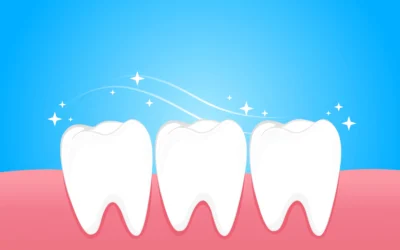Change is a part of life. And many of those changes are good. But, we would like some things to stay the same, don’t we? For example, it would be awfully nice if our teeth stayed the same pearly shade of white they were when they first grew in. But, life takes its toll on our teeth and sometimes that means a color change. And while white teeth aren’t a sure sign of healthy teeth, they are generally a good indicator and can boost our smile confidence as well.
Dental discoloration can come from two directions: Inside or outside. Let’s take a look at both directions, what causes the staining, and what we can do.
From the Inside
While we often think of yellowing or staining happening on the surface of our teeth, sometimes the root cause runs deeper. Excessive antibiotic or fluoride use, especially in children, can cause some deep discoloration in the tooth, appearing sometimes as overly white streaks in the enamel.
Damage or decay can also be a cause of discoloration. When the root of a tooth is damaged in an accident, for example, it can cause the tooth to “die” and fade to gray.
If the cause of the coloring is internal, whitening stips and gels won’t help. In fact, it can worsen the problem by lightening the unaffected parts of the teeth and making the colored bits stand out even more.
One option for treating internal tooth discoloration is to cover it up. There are a few cosmetic dental options for this approach:
- Veneers: This is a porcelain or resin cover that attaches permanently to the front of the teeth. It is usually only used for teeth in the front of the mouth.
- Crowns: Crowns are another permanent option, but they cover the entire tooth. The dentist casts a mold of the tooth, then sands it down and fits a cap over it that matches the shape of the original tooth.
- Composite Bonding: This is a long-lasting solution, though not permanent. It is a very simple procedure, the dentist applies a resin to fill in cracks or cover discolored surfaces.
If the discolored tooth has had a root canal previously, internal bleaching is another option your dentist may be able to offer. Unlike over the counter whitening remedies, internal bleaching must be performed in a dental office. The dentist drills a small hole in the tooth through which they insert whitening chemicals. The hole is temporarily filled, and the treatment is left in place for a week or two. Internal bleaching can be repeated as necessary to achieve the desired tooth coloration.
From the Outside
The causes of surface staining might not be surprising:
- Food: Eating the rainbow is a wonderful way to keep your body and teeth healthy, but only if that rainbow is fruits and vegetables. Foods or substances that are processed contain chemicals that, if used in excess, can cause a change in tooth color and might also have adverse effects on the health of your teeth.
- Drink: Water is the best drink for your teeth. It rinses everything clean. The rest of your body likes it too! Soda, tea, coffee, and wine are fun indulgences from time to time, but a steady stream can affect the enamel and change the color of your teeth.
- Tobacco: Whether you are chewing it or smoking it, tobacco stains teeth. Chewing is especially dangerous to your teeth and gums. It can cause problems much more severe than yellowing teeth. Quitting tobacco is a wonderful step for your overall health, whiter teeth are just a nice side effect!
- Vaping: While vaping might not have tobacco or tar, they often contain nicotine which also has its own staining power. Vaping is another habit to kick for overall health and a good step for dental health as well.
There are options to treat staining that is on the surface. You can start at the most accessible and easy option and move on to more in-depth treatments if you don’t find success at first.
- Whitening Toothpaste: There are a wide array of whitening toothpastes. You can pick out any whitening toothpaste sold at your store of choice.
- Over-the-Counter Whitening Treatments: If toothpaste doesn’t seem to be shifting the shade, the next step might be some whitening treatments you can do at home, such as gel trays or strips.
- Prescription Whitening Treatments: The next step might be checking with the dentist for a treatment that they can prescribe but can be done at home. These can be a less expensive option than in office treatments, but more effective than over-the-counter products.
- In-Office Whitening Treatments: You can go straight to this option or try the other steps first. There are several options available at your dentist’s office, such as gels and UV light treatment. They are safe and effective. Again, do some research before jumping to this option. Ask for referrals, visit with dentists, and look at before and after pictures. Make sure you feel comfortable and confident.
Prevention
The path to prevention of discoloration from the inside or outside is the same. These won’t be surprising.
- Brush
- Floss
- Use Mouthwash
- See Your Dentist
We know, you saw those coming, didn’t you? Taking care of your teeth won’t just keep them whiter, it will also keep them stronger and keep them in your mouth for a lot longer. Regularly cleaning them will help scrub away potential stains and a regular deep clean and polish from the dentist will keep things shiny and spot potential problems.
The confidence in your smile comes from deep within, but a whiter set of teeth can boost our confidence. Life changes everything, even our teeth, but as we take care of our teeth we can try to keep the shade of our teeth as close to the original as we can.



